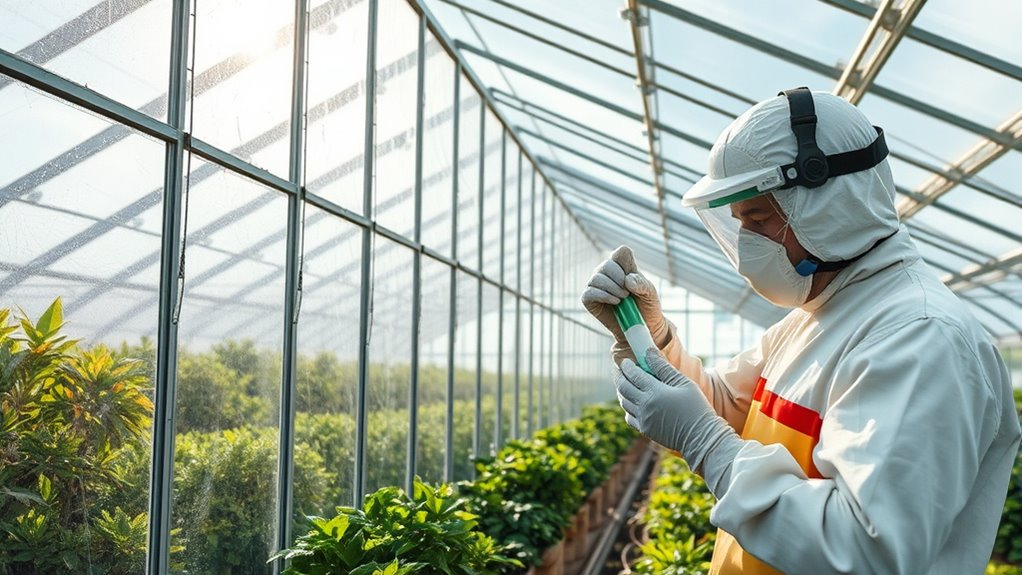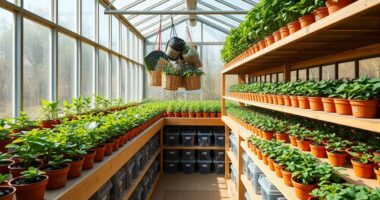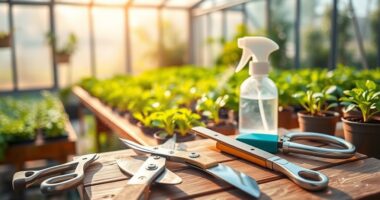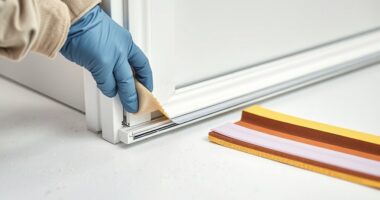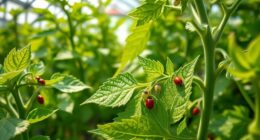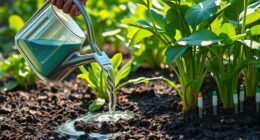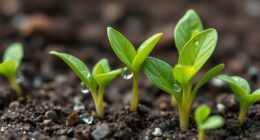To prevent and repair greenhouse damage, you should regularly inspect for cracks, loose fasteners, and warped panels, taking quick action to fix issues before they worsen. Use durable, impact-resistant, and weatherproof materials to extend lifespan. Reinforce structures, secure loose panels, and add storm protections like shutters. Maintain proper ventilation and control humidity to prevent mold and pest problems. Staying proactive with these strategies can save you costly repairs — explore more tips to keep your greenhouse in top shape.
Key Takeaways
- Conduct regular inspections for cracks, loose fasteners, and structural weaknesses; address issues promptly to prevent escalation.
- Reinforce structural elements and secure panels ahead of storms using impact-resistant and weatherproof materials.
- Use UV-resistant, impact-proof, and corrosion-proof materials to enhance durability and reduce damage risks.
- Maintain proper ventilation, temperature, and humidity levels to prevent stress and deterioration of greenhouse components.
- Implement pest prevention, keep pathways clear, and reinforce structures proactively to minimize long-term damage.
Regular Maintenance and Inspection Strategies
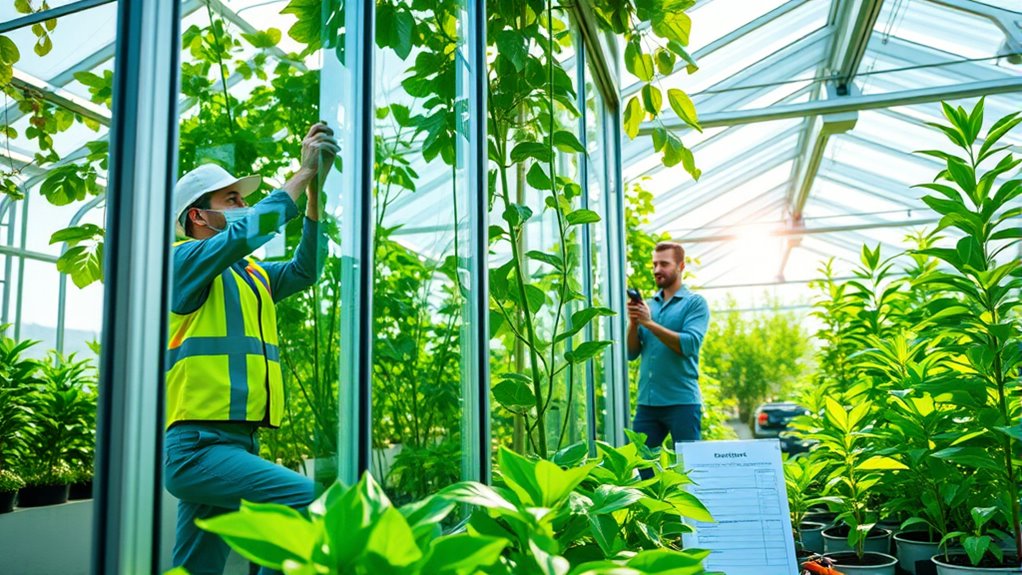
Regular maintenance and inspection are essential to preventing greenhouse damage before it happens. By routinely checking for signs of pests, you can catch infestations early and implement effective pest control measures, minimizing harm to your plants and structure. Incorporating pest detection strategies can help identify issues before they become severe. Prioritize soil health by testing and amending the soil regularly, ensuring proper nutrients and avoiding compaction or erosion that can weaken the greenhouse foundation. Using soil testing can help identify deficiencies and prevent long-term issues. Incorporating soil health management practices supports the overall resilience of your greenhouse environment. Keep vents, fans, and shading systems clean and functional to maintain exemplary conditions. Inspect seals, glazing, and framing for cracks or damage, addressing issues promptly. Regularly cleaning and maintaining these components prevents the buildup of debris and ensures optimal airflow and temperature regulation. Establish a consistent schedule for these tasks, and document your findings to track recurring problems. This proactive approach helps you identify vulnerabilities early, preserving the integrity of your greenhouse and supporting healthy plant growth. Additionally, incorporating regular health checks can help detect underlying issues before they escalate, ensuring the longevity and productivity of your greenhouse environment. Implementing preventive maintenance routines can further extend the lifespan of your greenhouse components and reduce costly repairs.
Selecting Durable Materials for Longevity
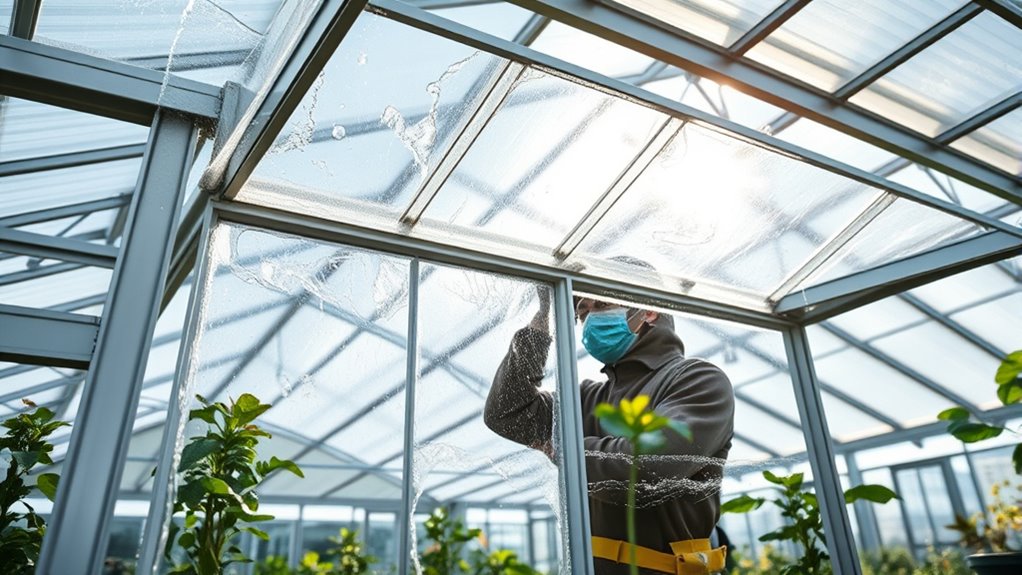
Choosing sturdy materials is essential for guaranteeing your greenhouse withstands environmental stressors and lasts over time.
Opt for UV resistant materials to prevent sun damage, which can weaken panels and reduce clarity. UV resistant plastics and glass help maintain the greenhouse’s structural integrity and ensure plants get adequate sunlight. Incorporating protective layering techniques can further enhance the durability of your panels against UV exposure. Additionally, selecting materials with a high impact resistance can prevent damage from hail or debris, further extending your greenhouse’s lifespan. Using advanced testing methods can help verify the durability of materials before installation.
Additionally, select corrosion proof components, especially for metal frames and fixtures, to prevent rust and deterioration caused by moisture and humidity. Corrosion proof materials extend the lifespan of your greenhouse and reduce maintenance needs.
Incorporating weather-resistant features further protects your structure from the effects of wind, rain, and snow, helping it endure diverse weather conditions. As AI technologies advance, leveraging AI-driven material testing can optimize material selection for maximum durability in specific environments.
By investing in these resilient materials, you protect your greenhouse from weather-related wear and tear, saving money on repairs and replacements.
Ultimately, durable, UV resistant, and corrosion proof choices give your greenhouse the strength to endure harsh conditions and serve you reliably for years.
Ensuring Proper Ventilation and Climate Control
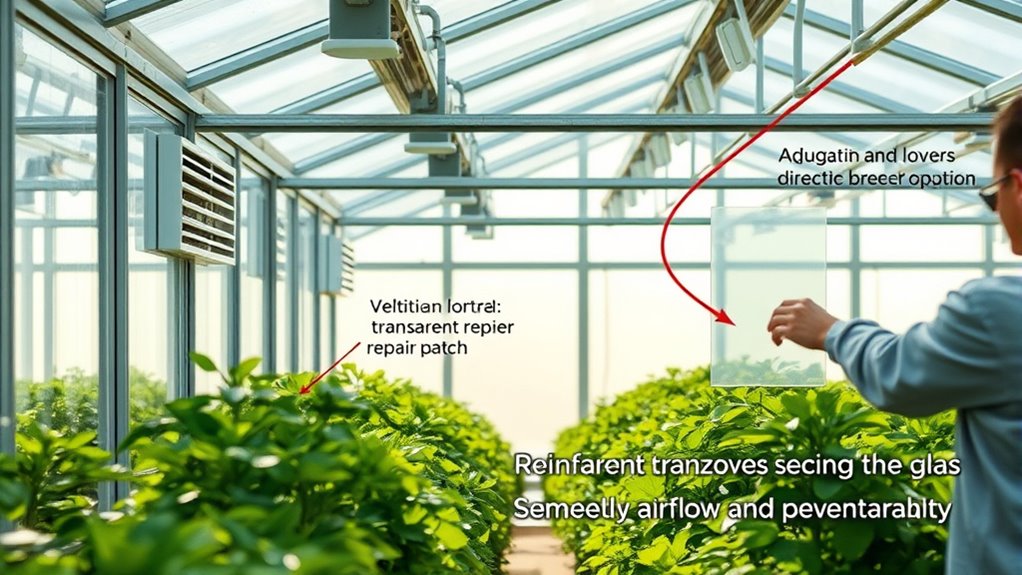
Maintaining your ventilation system guarantees fresh air circulation, which helps prevent mold and pests. Regularly check and clean vents to keep airflow consistent. Additionally, maximizing space and organization within your greenhouse can improve airflow and reduce clutter that may obstruct ventilation pathways. Proper air quality monitoring can also help detect issues early, ensuring optimal conditions for your plants. Balancing temperature and humidity levels is key to creating a healthy environment for your plants and avoiding damage. Implementing self watering plant pots can also contribute to climate stability by maintaining consistent soil moisture levels, reducing stress on your plants. Incorporating tuning techniques from automotive practices, such as monitoring and adjusting environmental parameters, can further optimize greenhouse conditions. Utilizing airflow measurement tools can assist in maintaining proper circulation and prevent stagnant air that fosters mold growth.
Ventilation System Maintenance
Ensuring proper ventilation and climate control is vital for preventing greenhouse damage, as it directly influences temperature, humidity, and airflow. Regular maintenance keeps your ventilation system functioning efficiently. Focus on airflow optimization by checking for blockages and ensuring fans are clean. Proper fan placement is essential; position fans to promote even air circulation without creating drafts. Inspect ductwork and vents for leaks or debris, and replace or repair damaged components promptly. Use the table below to help optimize your ventilation setup:
| Action | Benefit |
|---|---|
| Adjust fan placement | Improved airflow distribution |
| Clean and service fans | Consistent, efficient operation |
| Check ductwork for leaks | Maintains proper airflow and humidity |
| Replace worn parts | Prevents system failure and damage |
Additionally, implementing regular inspections can prevent unexpected system failures and ensure optimal performance. Utilizing automation in your ventilation system can further enhance climate regulation and reduce manual oversight. Regularly monitoring airflow patterns can help identify potential issues early, maintaining a healthy environment inside your greenhouse.
Consistent upkeep guarantees your greenhouse stays healthy and resilient.
Temperature and Humidity Balance
Effective temperature and humidity control are essential for preventing damage in your greenhouse, especially when proper ventilation isn’t maintained. Without adequate humidity control and temperature regulation, your plants become vulnerable to diseases, mold, and stress. Regularly checking environmental data can help you identify potential issues early. To achieve the right balance, monitor your environment regularly with sensors that track both humidity and temperature levels. Use ventilation fans, vents, or exhaust systems to remove excess heat and moisture, preventing conditions like condensation or overheating. Adjust shading or heating as needed to maintain consistent temperatures. Implementing smart climate control systems can further optimize environmental conditions and reduce manual adjustments. Proper climate control helps your plants thrive and reduces the risk of damage caused by extreme conditions.
Protecting Greenhouses From Weather-Related Damage
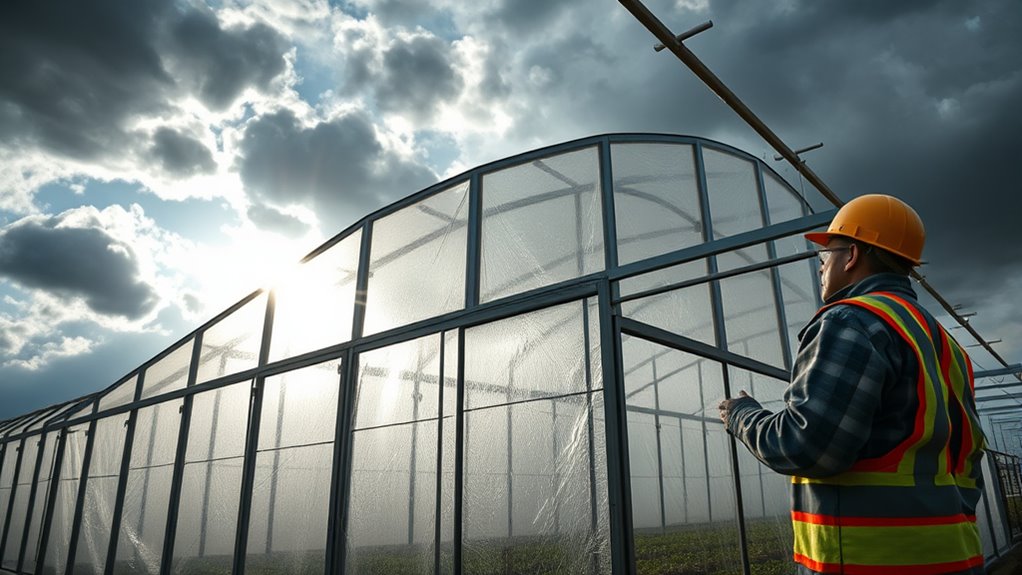
Weather-related damage can strike unexpectedly, but taking proactive steps can considerably minimize its impact on your greenhouse. Start with storm preparedness by securing loose panels and reinforcing structural elements. Make certain your greenhouse has high wind resistance by using sturdy materials and proper anchoring systems.
Regularly inspect and maintain the frame, looking for vulnerabilities that could worsen during a storm. Trim surrounding trees and remove debris that could become projectiles. Installing storm shutters or protective films adds extra security against flying debris.
Keep an emergency plan in place, including quick access to tools and supplies. These measures can help your greenhouse withstand severe weather, reducing damage and downtime. Being prepared not only protects your investment but also keeps your plants safe during unpredictable weather events.
Common Signs of Structural Weaknesses to Watch For
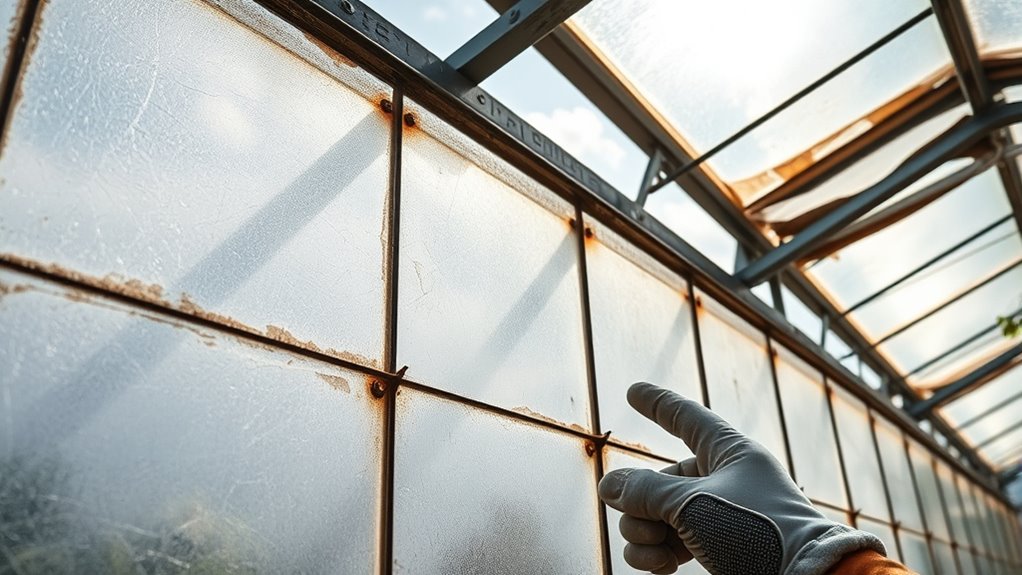
You should regularly check your greenhouse for signs of structural issues. Look for cracks in the frame, loose or missing fasteners, and panels that appear warped or bowed.
Catching these early helps prevent further damage and keeps your greenhouse safe and secure.
Cracks in Frame
Cracks in the greenhouse frame are one of the most obvious signs that structural weaknesses may be developing. If you notice these, it’s essential to address them promptly.
Small cracks can expand over time, compromising the frame’s stability. To prevent further damage, consider frame reinforcement methods, such as adding support braces or using stronger materials. Crack sealing is also vital to prevent moisture infiltration, which can weaken the structure further.
Here are key steps to take:
- Inspect cracks regularly to monitor growth.
- Seal small cracks immediately to prevent moisture entry.
- Reinforce weakened areas with appropriate supports or materials.
Addressing these signs quickly helps maintain your greenhouse’s integrity and prolongs its lifespan. Don’t ignore cracks—they’re early warning signs of potential failure.
Loose or Missing Fasteners
Loose or missing fasteners are common signs that your greenhouse’s structural integrity may be compromised. Over time, fastener types such as bolts, screws, or clips can loosen due to weather conditions or vibrations. Regular inspections help catch these issues early.
When installing fasteners, use the correct type for each application—galvanized or stainless steel options resist rust and corrosion. Tighten fasteners properly, but avoid over-tightening, which can damage materials.
Make sure all fasteners are securely in place, especially around joints and panels. Replacing missing fasteners promptly prevents further damage and maintains stability.
Following proper installation tips, like applying thread-locking compounds when needed, ensures a strong, lasting connection. Keeping fasteners secure is essential for your greenhouse’s overall strength and safety.
Warped or Bowed Panels
Warped or bowed panels are clear indicators that your greenhouse’s structural integrity may be weakening. This panel warping often results from material expansion due to temperature fluctuations or prolonged exposure to sunlight.
When panels bow or warp, it can compromise insulation and lead to further damage. To prevent this, watch for these signs:
- Visible warping or bulging in panels, especially after hot days.
- Gaps or cracks forming between panels and framing.
- Persistent moisture or condensation around warped areas, indicating compromised seals.
Addressing warped or bowed panels early helps maintain stability and prevents costly repairs. Regular inspections can catch these issues before they worsen, ensuring your greenhouse remains strong and functional.
Step-by-Step Repair Techniques for Common Issues
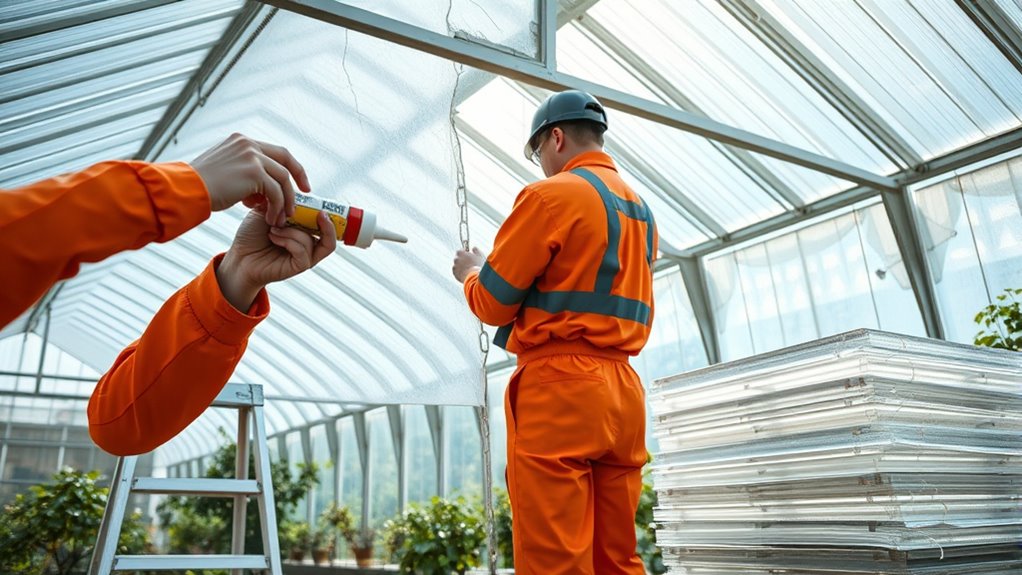
When addressing common greenhouse issues, taking a systematic approach to repairs guarantees your structure remains secure and functional. Start by identifying the problem—whether it’s a broken panel or pest intrusion. For pest control and prevention, inspect vents and seals regularly, sealing gaps to prevent pests from entering. Use the following table as a guide:
| Issue | Step-by-Step Repair | Tips |
|---|---|---|
| Cracked panels | Replace damaged panels with new ones | Wear protective gear |
| Loose frames | Tighten bolts and screws | Use appropriate tools |
| Pest infestations | Remove pests, apply safe treatments | Maintain cleanliness |
| Water leaks | Seal leaks with waterproof sealant | Check for recurring issues |
Consistency keeps repairs effective, ensuring your greenhouse stays healthy.
When to Call in Professional Repair Services
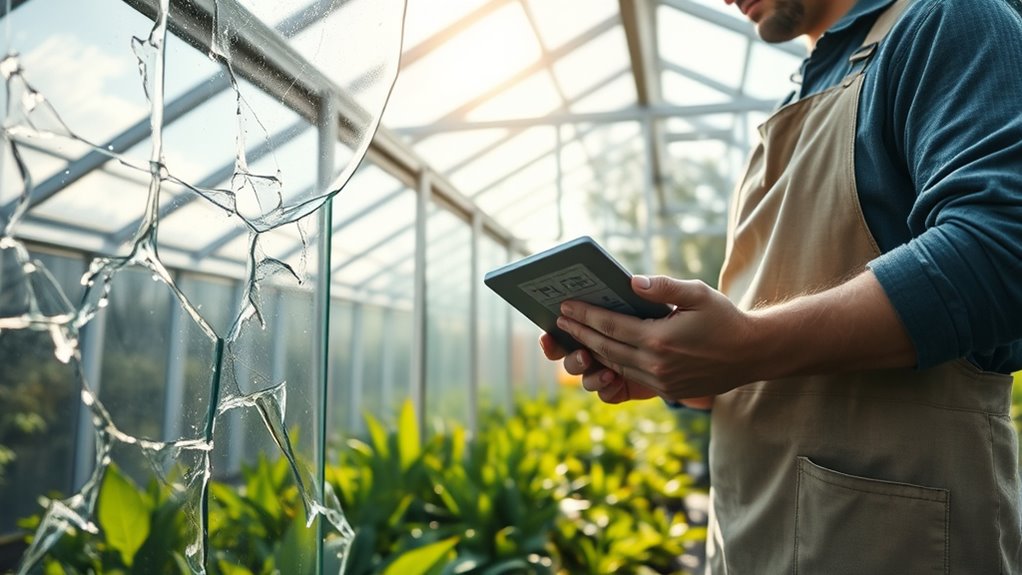
While some minor greenhouse repairs can be handled yourself, certain issues require professional expertise to guarantee safety and proper resolution. You should call in professionals for emergency repairs that involve structural damage, electrical problems, or extensive leaks. These situations can pose safety risks or cause further damage if not addressed correctly.
Consider professional repair services when:
Consider professional repairs when structural safety or insurance claims are involved.
- The damage affects the integrity of the greenhouse structure.
- You need to file insurance claims for significant storm or weather damage.
- The problem exceeds your skill level or requires specialized tools.
Professional repair services ensure repairs meet safety standards and help streamline insurance claims. Don’t delay calling experts for critical issues that could jeopardize your greenhouse’s longevity or your safety.
Preventative Measures to Minimize Future Risks
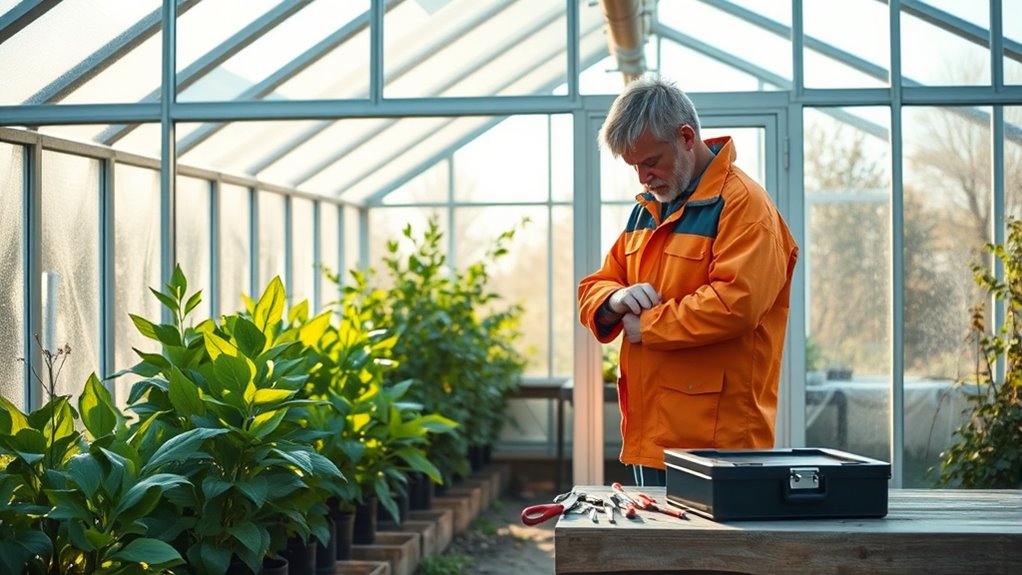
Implementing preventative measures is essential for reducing the risk of damage to your greenhouse before problems arise. Focus on pest prevention and maintaining plant health to avoid costly issues later. Regularly inspect plants for signs of pests or disease, and remove infected specimens immediately. Ensure proper ventilation to reduce humidity, which discourages mold and pests. Use physical barriers like screens to keep out insects. Keep pathways clear to prevent accidents. Proper watering and fertilization promote healthy plants, making them less vulnerable. Here’s a quick overview:
| Pest Prevention | Plant Health | Maintenance |
|---|---|---|
| Screen insect entry | Regular inspections | Clean and organize |
| Remove weeds | Proper watering | Check for damage |
| Use natural predators | Fertilize appropriately | Fix structural issues |
Frequently Asked Questions
How Can I Prevent Pest Infestations in My Greenhouse?
To prevent pest infestations in your greenhouse, you should focus on pest prevention and infestation control strategies. Start by inspecting plants regularly for signs of pests, and keep your greenhouse clean to reduce hiding spots.
Use physical barriers like screens, and introduce beneficial insects to naturally control pests. Avoid overwatering and ensure proper ventilation, as these conditions help hinder pest problems.
Consistent monitoring and proactive steps are key to maintaining a healthy greenhouse environment.
What Are the Best Ways to Store Greenhouse Materials During Off-Season?
For seasonal storage and material preservation, you should clean and dry all greenhouse tools and supplies thoroughly before storing them.
Use sealed containers or durable storage sheds to keep materials protected from moisture, pests, and dust.
Label everything clearly, and store delicate items in climate-controlled areas if possible.
Proper organization and protection guarantee your materials stay in good condition, ready for use when the next season begins, saving you time and money.
How Does Plant Placement Affect Greenhouse Structural Integrity?
Think of your greenhouse as a house of cards—plant placement plays a crucial role in its structural stability. You should position taller plants away from wind-prone areas to enhance wind resistance.
And evenly distribute weight to prevent stress on the structure. Proper placement helps maintain wind resistance and overall stability, ensuring your greenhouse withstands tough weather.
Smart plant positioning keeps your greenhouse standing tall and resilient, no matter what weather comes your way.
Are There Eco-Friendly Options for Repairing Greenhouse Damages?
When it comes to repairing greenhouse damage, you can choose sustainable repair options using eco-friendly materials like recycled plastics, bamboo, or natural sealants. These alternatives help reduce environmental impact while restoring your structure’s integrity.
You’re actively supporting eco-conscious practices by avoiding harmful chemicals and opting for renewable resources. This approach not only repairs efficiently but also promotes a healthier environment.
Ensuring your greenhouse remains sustainable and eco-friendly for years to come is a key benefit of these repair choices.
How Can I Monitor Greenhouse Health Remotely?
Imagine your greenhouse as a living heartbeat; to keep it thriving, you need to listen closely. You can monitor its health remotely by integrating sensors that track temperature, humidity, and light levels. These sensors feed data into a system for remote diagnostics, allowing you to spot issues early.
With this setup, you stay connected, ensuring your greenhouse stays healthy and productive, no matter where you are.
Conclusion
By staying vigilant and proactive, you’re the guardian of your greenhouse’s health. Think of regular maintenance as tending a delicate garden—your efforts keep it thriving amidst storms and sunshine. When you spot trouble, address it swiftly like a skilled surgeon mends a wounded plant. With careful care and timely repairs, you’ll guarantee your greenhouse remains a resilient sanctuary, a fortress of growth that stands tall against nature’s unpredictable dance.
